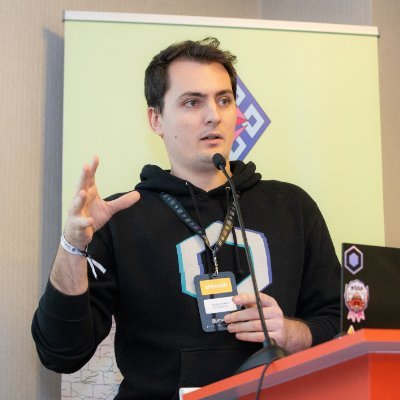11 Weeks Of Online Classes
Solidity Bootcamp
Your Journey Explained
How It Works
Highly structured curriculum
10 students per cohort
Daily assignments that can be finished in under 1 hour
11 x weekly live classes (group sessions)
11 x weekly 1-1 calls with the instructor (15 - 30 mins)
Total time commitment is less than 7 hours per week
Structured For Success
Solidity Bootcamp Curriculum
Review of Intermediate Syntax
ERC-20 Security Drills
Token Contract Drills 1
Token Contract Drills 2
Solidity DeFi Math 1
Solidity DeFi Math 2
Flash Loans
Vaults and How They Break
Uniswap V2 Exercises
Uniswap V2 Math Derivation
Hacking Uniswap V2 Forks
How we choose what topics to cover
DeFi will feel easy after this
- A mechanism for investors to deposit liquidity (with the expectation of a profit)
- A mechanism for traders to use the liquidity (such as for swapping, borrowing, or leveraged trading)
- An accounting mechanism to track profit share for the investors
- Solidity Syntax
- ERC-20 Usage
- Math in Solidity
- Vaults
- Flash Loans
- Uniswap V2
Solidity Syntax
Tokens
Math
Vaults
Flash Loans
Uniswap V2
- Fee-On-Transfer Tokens
- Rebasing Tokens
- The Safetransfer Pattern
- Fixed-Point Numbers And Fixed-Point Arithmetic
- Accumulator Accounting
- Lp Tokens And Vault Design Patterns
- Fee-By-Dilution
- Flash Loans
- Factory Pattern And Create2
Topics we do not cover
Oracles
Proxies and upgradable contracts
DAOs and Governance
Unit testing
Invariant Testing / Formal Verification
NFTs (ERC-721)
How we design our assignments
We learned through experience that “project-based learning” is an inefficient use of time. We replaced it with “exercise-driven training”.
Many educators mistakenly confuse “learning by doing” with “project based learning”. It’s better to work on exercises that are designed to give rapid feedback rather than leave students to explore on their own and get delayed feedback as to whether they understood a concept correctly or not.
Here is why project-based learning is suboptimal
To get a project to function, there is a strong temptation is to copy working code from Stack Overflow or an LLM without understanding how it works. This is fine for a job or hackathon where you are evaluated on shipping features rather than knowing what you are doing. But it is counterproductive for efficient learning as your time is spent expertly crafting your Google search or LLM prompt instead of internalizing a design pattern.
People learn faster when they get direct feedback on their mistakes. A “functional” project doesn’t give as much feedback as targeted exercises do. We design our course to maximize feedback. Our exercises are designed to “bite-back” quickly even if a small mistake is made.
Instead, we ask engineers to write code we have already prepared aggressive unit tests for. When the engineer forgets to include a safety feature or deviates from best-practices, the unit tests will give rapid feedback for the engineer to course correct. On top of that, we have 1-1 code reviews with the instructor, but a pre-existing unit test will always provide faster feedback than an instructor can. In our course, you get the best of both worlds.
Even professional code reviewers (aka auditors) miss issues in large codebases; it’s very hard to reliably catch every mistake a coder makes. If an engineer learns by creating several projects, but makes more than a few uncaught mistakes, this can lead to engineers creating several projects while also unconsciously enforcing bad habits. That’s why we scope our exercises down to where the number of mistakes that could be made are limited and easy to catch.
We learned through experience that “project-based learning” is an inefficient use of time. We replaced it with “exercise-driven training”.
Summary
Old Method
- Delayed feedback on mistakes
- Important topics can be missed
- Random exploration
- Waste time on less important knowledge
RareSkills Method
- Instant feedback on mistakes
- Guaranteed to drill the important subject
- Practice subjects from multiple angles
- Concentrate on high-impact knowledge
Over 1,000 Stars
Check Our GitHub
Meet Your Mentor
Your Instructor
Welcome Onboard
Onboarding Process
1
Apply To Enroll
2
Payment
3
Course Access
4
Attend Class
Flexible Plans
Solidity Bootcamp Pricing
- 11 × Weeks Live Classes
- Small Class Size (10 students)
- 11 × 1-on-1 Code Reviews & Mentoring Sessions
- Pre-course Material
- Course Material (Lifetime Access)
- Access to the RareSkills Slack and Discord Community (Lifetime Access)
Making Their Mark
Our Impressive Alumni
Everything You Need To Know
Frequently Asked Questions
Who is this for?
This program is for busy engineers who want to upskill in Solidity, but have a job that keeps them busy. Learners who feel stuck in a “doom loop” of studying Solidity but still not being able to make sense of large codebases will also benefit from this.
Is this course a fit for me?
Here is how you know if this program is a good fit or not:
- You value active learning and deliberate practice over passive content consumption
- You see value in trading money to gain higher ROI on your time
- You see time as limited and precious commodity, but money as uncapped
- You want to cover knowledge gaps in Solidity
- You have some other obligation that limits the amount of time and energy you can put into upskilling
- If you have a lot of time on your hands, we recommend working through the puzzles on our Github and going through our Solidity developer Roadmap.
Please note, there is no “secret tutorials” that we save for our premium members. What you are paying for is instructor time and lifetime access to one of the most respected communities in Web3.
Your content is free, why would I pay?
There is absolutely nothing stopping you from working through the exercises on your own and reading the relevant blog articles on RareSkills!
The majority of people who use RareSkills to upskill only use our free material, so it’s perfectly fine if that’s you.
Our claim is you can develop a deep level of understanding of all the subjects listed above in 77 hours using this bootcamp (7 hours per week over 11 weeks). We’ve seen engineers put over 150 hours into study on their own and not achieve the outcomes of this course. So if this course saves you 73 hours (150 – 77) on your learning journey, then you can decide based on your hourly rate, whether this is positive ROI for you.
You should also consider the *likelihood* of completing all the materials as quickly independently as opposed to a community. “Accountability” can be a scary word, but you can also think of this course as “outsourced motivation to stick to an important habit.” In our view, that is a high ROI way to spend money.
I’m trying to get into Web3 auditing, is this course suitable?
Absolutely. RareSkills is the #1 resource for auditors in Web3. Auditors from very established audit firms (such as OpenZeppelin, Consensys, Spearbit, Sherlock, Certora, Immunefi etc) read our materials regularly and frequently cite our articles in audit reports.
Although this isn’t a “security” course per-se, you will still get a lot of practice spotting realistic bugs in production code.
That said, we cannot provide any guarantees about how successful your security career will be — although we should point out that some of our alumni have been *wildly* successful.
What are the prerequisites?
For Tokens to DeFi, you should have coded an ERC-20 before, or an NFT.
If you are completely new to Solidity, please spend two weeks on our free Learn Solidity tutorial.
What happens after I apply?
If we think you are a potential fit, we will reach out to you for an interview.
Do you guarantee a job?
No. Job guarantees are a marketing gimmick. Your career is completely your responsibility and it cannot be delegated for a price.
We run a Web3 engineering recruitment agency and have directly helped dozens of engineers get new jobs, both from this bootcamp and from non-students who join our recruitment agency through other channels.
We have direct relationships with some of the most influential companies in the Web3 space (meaning we talk with their founders regularly, not that we decided to slap their logo on our website). So we *know* what we are talking about here.
Employers overwhelmingly care about past production experience with Web3. Your “certificates” and “courses” hold zero weight.
This obviously creates a significant chicken-and-egg problem for engineers who didn’t join Web3 more than two years ago!
You break the chicken-and-egg problem of experience by repeatedly proving your smart contract skills in a competitive environment such as a hackathon, smart contract security audit contest, or by delivering on grants or bounties for blockchain foundations. You don’t break the chicken-and-egg problem by getting a certificate. There is no industry-recognized certificate that accomplishes it.
Fundamentally, you need to prove you are better than other engineers who want the same job, which can only be done in a competitive setting.
By proving yourself in a competitive setting, you show that you have more of a measurable skill than other candidates and that you have higher intrinsic motivation.
If you are just looking for a new blockchain job, please note that you do not need to be a RareSkills student to use our recruitment agency. You do not need to pay anything or be part of the RareSkills community to use our recruitment services. Fill out the form in RareTalent. If we accept your application, you will get a free 30 minute consultation to work on your resume.
Why is the course eleven weeks long?
A business quarter has 13 weeks. Since our customers are working professionals for the most part, we find they can accurately forecast their availability up to one quarter in advance, then things become unpredictable.
Therefore, we make our course 11 weeks long to buffer for holidays or major conferences. During major web3 developer conferences (such as Devcon), we may institute a week long vacation for the course and pick up where we left off the week after.
We take vacations during Lunar New Year, New Year, and Christmas week. If a class falls on Eid al-Fitr, Diwali, Thanksgiving, or Good Friday, the class may be postponed depending on the preferences of the class. All postponed classes will be made up for.
I’m a company and I want to train my engineers
Please connect with us here.










